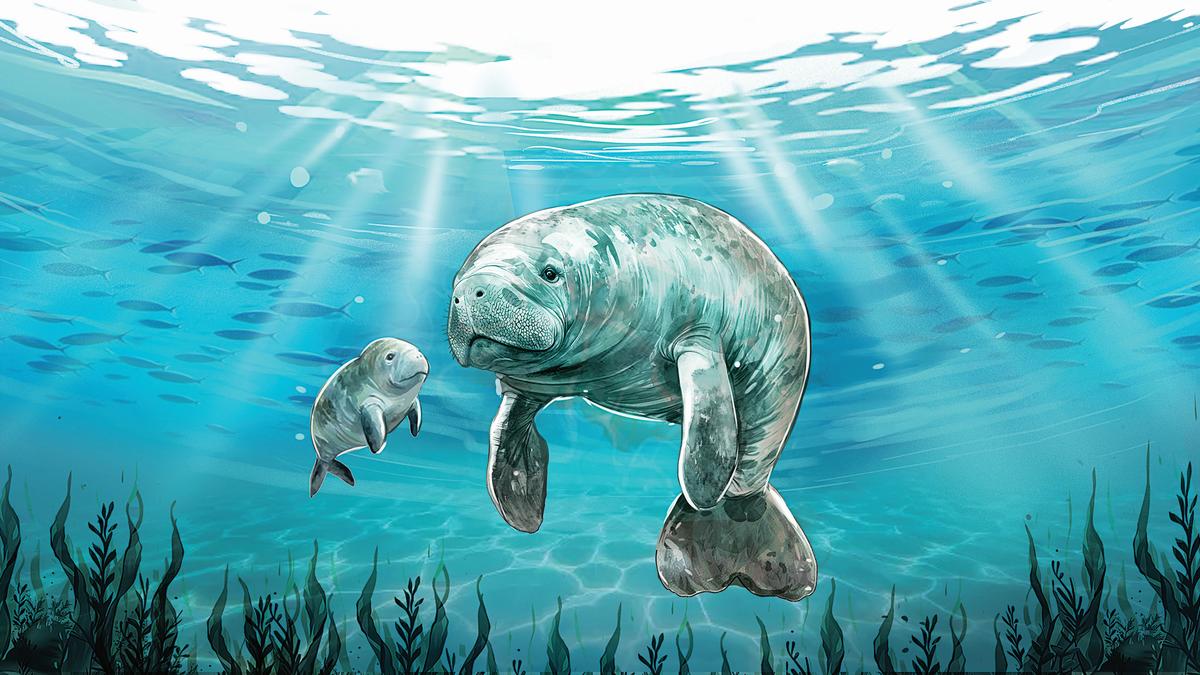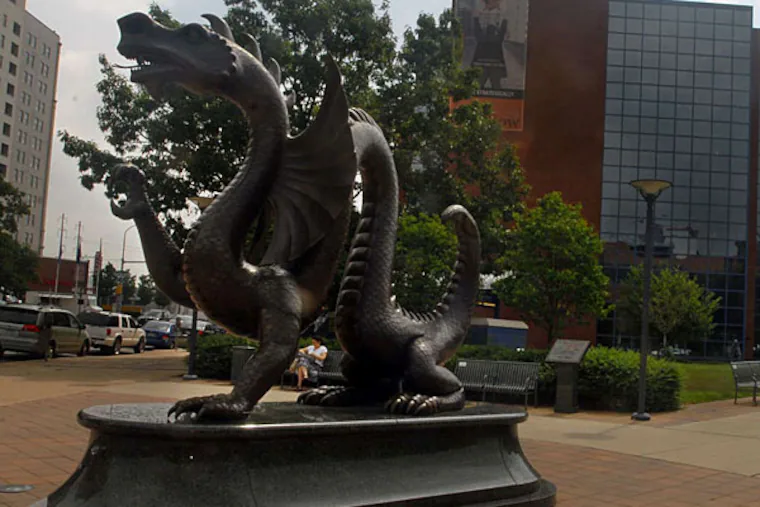By R Rajaram
Copyright thehindu

In a double delight, Tamil Nadu has recorded a rise in the population of dugongs, a regionally endangered species, and the State’s efforts to protect the sea mammals that were once on the brink of extinction have won international recognition as a model. A multi-pronged conservation effort by the government, supported by the Wildlife Institute of India (WII), focusing on prevention of poaching, rescue and release, community involvement and habitat restoration, has contributed to the recovery of the mammals in the Palk Bay and the Gulf of Mannar (the PB-GoM region) along the Tamil Nadu coast.
Commonly known as sea cows, dugongs (Dugong dugon) are often referred to as the “farmers or gardeners of the sea” for their important role in preserving the coastal ecosystems and aiding fish production. Growing up to three metres long and weighing over 400 kg, these gentle giants are found in warm waters along coastlines, mainly confined to seagrass beds which occur in calm sheltered habitats such as bays and lagoons. They are found in the Gulf of Mannar, the Palk Bay, the Gulf of Kutch and the Andaman and Nicobar Islands in India. Dugongs are primarily herbivorous, grazing on 30 kg-40 kg of seagrass a day.
The species is listed as Vulnerable to Extinction on the International Union for Conservation of Nature (IUCN) Red List. Once abundant in Indian waters, dugongs are protected under Schedule I of the Wild Life (Protection) Act, 1972. But their population was on the decline over the past several decades owing to a variety of factors, including hunting for meat, commercial fishing practices leading to accidental drowning, and habitat degradation.
In a major measure to protect the species, the government, in September 2022, notified 448.34 square kilometres in the northern Palk Bay as a Dugong Conservation Reserve, under the Wild Life (Protection) Act. The region is home to over 12,250 hectares of seagrass meadows, a vital feeding ground for dugongs.
IUCN recognition
Last week, the IUCN formally adopted a motion recognising India’s first Dugong Conservation Reserve in the Palk Bay spread over Thanjavur and Pudukkottai districts. The motion, proposed by the OMCAR (Organisation for Marine Conservation, Awareness and Research) Foundation, a non-profit involved in the conservation efforts, was adopted at the IUCN World Conservation Congress 2025 in Abu Dhabi, with overwhelming support from members worldwide in online voting. Chief Minister M.K. Stalin took to X to announce it and appreciate the Tamil Nadu Forest Department and conservation partners for their efforts in securing the recognition.
The motion recognised and appreciated the establishment of the reserve as a “critical step towards marine biodiversity conservation in South Asia and an exemplary model for dugong conservation globally”. It also welcomed the innovative eco-friendly restoration techniques, which involve the use of bamboo frames, to promote seagrass habitat recovery.
The recognition came as the icing on the cake as a recent survey carried out by the WII had pointed to a rise in the population of dugongs in the PB-GoM region, the most important among the three habitats of the mammals in India. The drone survey, conducted between March and May this year by the WII, has estimated that the region is now home to more than 200 dugongs.
“We have completed the drone survey, with a standardised technique, covering the Palk Bay area from Adhirampattinam to Ammapattinam, the dugong conservation reserve area, besides the Southern Palk Bay region in Ramanathapuram division and the Gulf of Mannar. The estimate points to a dugong population of more than 200 in this region alone; the exact number is likely to be higher. The findings will be published soon,” J.A. Johnson, senior scientist, WII, told The Hindu. According to him, the country was estimated to have around 250 dugongs in the three habitats in 2012-13. Given the vast seagrass meadows here, the Tamil Nadu coast always had the largest population.
India is believed to have had a large dugong population 70-80 years ago, but a lot of them were hunted for meat down the years before they came to be legally protected, says K. Sivakumar, former Chief Scientist, WII, currently a professor in the Department of Ecology and Environmental Sciences of the Pondicherry University. “There were no direct sightings of the animal by researchers after the 1970s. In the early 2000s, we thought it could have become extinct and in 2008, I proposed a study,” he recalls. Subsequently, the Central government constituted a Task Force for Conservation of Dugongs in India, and a national dugong recovery programme was launched in partnership with the governments of Tamil Nadu, Gujarat and the Andaman and Nicobar Islands, which were already carrying out conservation efforts. The initiative was also funded by the Compensatory Afforestation Fund Management and Planning Authority (CAMPA) of the Union Ministry of Environment, Forest and Climate Change.
Poaching checked
“The first step was to stop poaching. Thanks to the awareness measures, poaching has almost been eliminated now, though instances of dugongs getting caught in fishing nets and drowning [dugongs must surface frequently to breathe] are being reported sporadically. But fishers are voluntarily rescuing the animals trapped as bycatch. I estimate there would be 200 to 300 dugongs here now, thanks to the conservation efforts,” Dr. Sivakumar adds.
“The conservation efforts have definitely contributed to the increased number. The Tamil Nadu Forest Department has been proactive and the involvement of local communities and the NGOs is also commendable. The notification of the reserve was a big step as it presented a lot of challenges,” said Dr. Johnson.
“The dugong’s return shows how government action, science and communities can together script a rare species revival,” said Supriya Sahu, Additional Chief Secretary, Environment, Climate Change and Forests, Tamil Nadu, in a post on X. Speaking to The Hindu, she attributed the success of the conservation efforts to the strong political will, bureaucratic commitment, and excellent execution strategy in the State. “The actions initiated over the past four years are part of a larger vision of the State government — that conservation has to be a priority. Every species is important and it is a legacy we are creating for the next generation. It is a very strong conservation pitch,” she said.
The State, she said, had gone about dugong conservation in a very systematic way. “We started with a lot of research, scientific evidence, and data. The species is highly endangered and if we had not provided legal protection, they could have become extinct,” she said, terming the notification of the reserve as a strong legal and revolutionary action taken by the State.
This, she said, was backed by measures aimed at habitat restoration, and involving the local communities to make fisherfolk the first responders in rescue efforts. “Dugongs are important in protecting the coastal ecosystem. Habitat restoration is very important; if the habitats disappear, the species disappears. So we partnered with the National Centre for Sustainable Coastal Management, the Suganthi Devadason Marine Research Institute and local NGOs, such as OMCAR Foundation, to execute our strategy, including seagrass restoration,” she said. Initially, the activities were taken up under the Japan International Cooperation Agency (JICA)-supported Tamil Nadu Biodiversity Conservation and Greening Project for Climate Change Response and other projects. Now, the initiatives are supported under the Tamil Nadu Coastal Restoration Mission (TN-SHORE) too.
Since community participation is very important for sustainable conservation, about 150 awareness programmes have been conducted among fisherfolk and self-help group members to sensitise them to the importance of dugong conservation and how to rescue them when they get entangled in fishing nets. Thanks to the programmes, nine rescues have been carried out in the last two years. “We are also compensating the fishermen for the loss of nets which are cut during rescue. We also recognise fishers for such acts of stewardship through a reward programme. The government, the local communities, research institutions, and NGOs have all rallied around dugongs,” Ms. Sahu affirmed.
“The outreach programmes were part of a strategy to drive home the message to the coastal villagers that protection of dugongs and their habitats would be beneficial to the fishermen in the long run,” said a Forest Department official in Pudukkottai.
As part of the outreach, a scholarship programme was introduced for the children of fisherfolk as a socio-economic survey indicated a high dropout rate among school students in the coastal villages. “We called them dugong ambassadors and reached the fishers through them towards bringing about a change in mindset,” says Dr. Sivakumar.
Alongside sensitisation programmes, the Forest Department in Pudukkottai and Thanjavur had taken up the task of restoring seagrass meadows with the involvement of OMCAR Foundation. “Restoration is a laborious exercise and takes time; we are involving fishermen not only in rescue and release of dugongs but also in restoration,” said V. Balaji, Director, OMCAR Foundation. The restoration was carried out at sites selected based on drone imagery in the Dugong Conservation Reserve in the Palk Bay. In Pudukkottai district, it covered 1,000 square metres to establish seagrass patches in 10 different sites by using eco-friendly bamboo frames and coir ropes.
Biodegradable materials were used to ensure sustainable restoration without causing any harm to the natural environment below the sea, said the official. Involving local fisherfolk, healthy seagrass sprigs of Syringodium isoetifolium, Cymodocea serrulata and Halodule pinifolia were transplanted carefully in the designated area in the sea. A similar initiative on 1,000 square metres was taken up along the coastal regions of Valluvanpattinam and Somanathapattinam in Thanjavur district, the official said. “Over the past four years, we have restored 31 acres of seagrass habitat under various projects, including TN-SHORE,” Ms. Sahu said.
Conservation Centre
The State had also decided to set up an International Dugong Conservation Centre at Manora, a popular picnic spot along the Palk Bay. “This will be a unique centre with several elements. It will give a further push to raising awareness and keep the species in focus so that it rallies everyone. The centre will be a hub of information and activity, for researchers and students. It will also be an eco-tourism site. The tendering process is under way, and we are evaluating the bids,” she said.
Despite the success of the efforts, experts say there is still much work to be done. “Seagrass beds are often damaged by the use of drag nets used by country boats and the movement of boats, besides other factors. We continue to sensitise fishermen to such issues,” said Dr. Balaji. Experts also emphasise the need for stronger regional cooperation, especially with Sri Lanka, as dugongs travel long distances and move to the Sri Lankan shores from the Tamil Nadu coastline. Underlining the importance of sustaining the conservation efforts, Dr. Sivakumar said, “Now that we have started seeing the results, we should not let them go to waste.”



